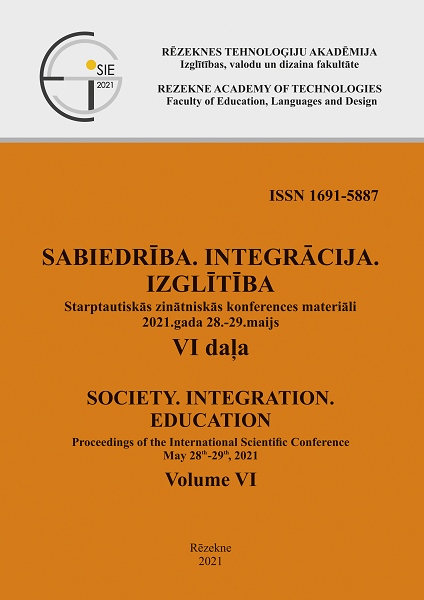SCHENGEN BORDERS CODE IN THE ASPECT OF BORDER SECURITY
DOI:
https://doi.org/10.17770/sie2021vol6.6478Keywords:
Schengen Borders Code, third-country national, alien, border control, threat to public healthAbstract
Latvia has joined the Schengen area in 2007 and has already passed three Schengen evaluations. The aim of the article is to analyse the Schengen Borders Code in the context of border security. Based on analysis of the Schengen Borders Code implementation in Latvia the author develops and puts forward suggestions on Schengen Borders Code content improvement as well as its judicial systematisation development.
The research tasks include the investigation of the current EU and national normative regulations, legal practices, the conclusions of Latvian and foreign law researchers by using analytical, historical and comparative methods.
The improvement of the national normative regulation was started long before Latvia's accession to the Schengen area. In 2006, the Schengen Borders Code entered into force, which was revised due to the migration crisis in the Mediterranean region and adopted in 2016 in an improved version. The further development of the Schengen Borders Code is important from the point of view of the right to free movement of persons and from the point of view of ensuring public security in the face of today's challenges related to terrorism, international crime, uncontrolled migration and the spread of disease.
The main achievement of the research is that the author has defined the main areas of Schengen Borders Code further development.
Downloads
References
European Commission (EC). (1995). Schengen Convention. Retrieved from https://www.refworld.org/docid/3ae6b38a20.html
European Commission (EC). (2001). Council Directive 2001/51/EC of 28 June 2001 supplementing the provisions of Article 26 of the Convention implementing the Schengen Agreement of 14 June 1985. Retrieved from https://eur-lex.europa.eu/legal-content/EN/ALL/?uri=CELEX%3A32001L0051
European Commission (EC). (2003). Council Directive 2003/110/EC of 25 November 2003 on assistance in cases of transit for the purposes of removal by air. Retrieved from https://eur-lex.europa.eu/legal-content/EN/TXT/?uri=CELEX:32003L0110
European Commission (EC). (2004). Directive 2004/38/EC of the European Parliament and of the Council of 29 April 2004 on the right of citizens of the Union and their family members to move and reside freely within the territory of the Member States amending Regulation (EEC) No 1612/68 and repealing Directives 64/221/EEC, 68/360/EEC, 72/194/EEC, 73/148/EEC, 75/34/EEC, 75/35/EEC, 90/364/EEC, 90/365/EEC and 93/96/EEC (Text with EEA relevance).
European Commission (EC). (2008). Directive 2008/115/EC of the European Parliament and of the Council of 16 December 2008 on common standards and procedures in Member States for returning illegally staying third-country nationals. Retrieved from https://eur-lex.europa.eu/legal-content/EN/TXT/?uri=celex%3A32008L0115
European Commission (EC). (2016). Regulation (EU) 2016/399 of the European Parliament and of the Council of 9 March 2016 on a Union Code on the rules governing the movement of persons across borders (Schengen Borders Code). Retrieved fromhttps://eur-lex.europa.eu/legal-content/EN/TXT/?uri=CELEX:32016R0399
Eiropas Komisija (EK). (2010). EK pārstāvniecības Latvijā Preses un informācijas nodaļa. EK: Par Šengenas Robežu kodeksa piemērošanu. LV, 2010. 15.okt., nr.164.
EURLex. (2003). Convention determining the State responsible for examining applications for asylum lodged in one of the Member States of the European Communities - Dublin Convention Council Regulation (EC) No 343/2003 of 18 February 2003 establishing the criteria and mechanisms for determining the Member State responsible for examining an asylum application lodged in one of the Member States by a third-country national. Retrieved from https://eur-lex.europa.eu/legal-content/EN/TXT/?uri=CELEX:32003R0343
EURLex. (2009). Consolidated version of the Treaty on the Functioning of the European Union. Retrieved from https://eur-lex.europa.eu/legal-content/EN/TXT/?uri=celex%3A12012E%2FTXT
Kūtris, G. (2008). Likumu robi un Eiropas konstitucionālās tiesas. Eiropas konstitucionālo tiesu konferences XIV kongress. JuristaVārds, nr.24. Retrieved fromhttp://www.juristavards.lv/index.php?menu=DOC&id=177319
LR Saeima. (2009). On the State Border of the Republic of Latvia, 2009. Retrieved from https://likumi.lv/ta/en/en/id/201364
LR Saeima. (2003). Latvian Immigration Law. Retrieved from https://likumi.lv/ta/en/en/id/68522-immigration-law
LR Ministru Kabinets. (2010). Regulations Regarding Border Crossing Points and Checks to be Performed Therein. No. 704, 2010. Retrieved from https://likumi.lv/ta/en/en/id/214844
O gosudarstvennoj granice Rossijskoi Federacii. (1993). О Государственной границе Российской Федерации: Закон РФ от 1 апреля 1993 г. N 4730-I. Retrieved from http://femida.info/11/fzoggrrf003.htmcт.9.
O gosudarstvennoj granice Respubliki Belorus. (2008). О Государственной границе Республики Беларусь: Закон Республики Беларусь от 21 июля 2008 г. № 419-З. Retrieved from http://newsby.org/news/2008/07/21/text11760.htmcт.5.
United Nations (UN). (1982). United Nations Convention on the Law of the Sea (UNCLOS). Retrieved from https://www.un.org/depts/los/convention_agreements/texts/unclos/unclos_e.pdf
United Nations (UN). (1985). Declaration on the human rights of individuals who are not nationals of the country in which they live UN. Retrieved from http://www.un.org/documents/ga/res/40/a40r144.htm
VVC. (2001). Levita E. Priekšvārds, Konsolidēts Eiropas Kopienas dibināšanas līgums un Nicas līgums. Mācību līdzeklis sabiedrisko zinātņu studentiem. Rīga: Preses nams poligrāfijas grupā Jāņa Sēta, Retrieved from: http://www.vvc.gov.lv/export/sites/default/LV/publikacijas/konsolidetsekligums-17.pdf


